At-home composting is super simple and produces great results to help your garden grow!
When we saw the ever increasing prices of grocery store produce (along everything else!) a few years back, we decided it was time to get serious about home gardening and self-sufficiency. We started with four raised garden beds and now have eight! It's been a learning experience for sure, but we have been dedicated to the process and have been happy with the results of our gardening commitment, and it has been so rewarding to harvest (and eat) a bounty of fresh vegetables, herbs, and fruits!
Soil Amendments & Composting
Store-bought organic garden & potting soil, fertilizers, and mulch can be very expensive. So, a few years ago we built our own composting bin using a 32-gal trash can. We drilled holes in the lid and in the bottom of the container (for air flow) and began to feed it with our organic, compostable kitchen scraps. The process using this method requires rotation by hand, using a long handled 3-prong garden tool, and adding moisture when needed.
What's in the Compost?
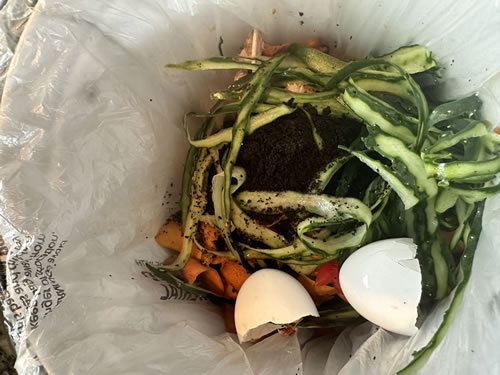 Our compost bin consists of:
Our compost bin consists of:
- Vegetable & Fruit Peels (except citrus, potato)
- Fruits & Vegetables past their prime
- Old Dried Herbs & Spices
- Spent Coffee Grounds
- Used Tea Leaves (remove the used tea leaves and toss the bag, staple & string)
- Egg Shells, rinsed
- Egg Cartons, shredded (made with recycled paper pulp or plant-based fiber only)
- Newspaper, Cardboard (non-glossy), Paper Towel & Toilet Paper Tubes, and Unbleached Paper, shredded
- Garden waste (ground-level leaves, edible/medicinal flower deadheads & pinched herb flowers, dead plants, unused garden produce, etc. but do NOT compost any invasive plants!)
- And, from time to time, we toss in old bagged potting soil and/or peat moss, and and add a bit of water to the bin
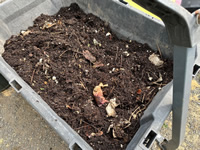 Throughout the year, but especially in autumn, we add yard clean up debris and annual patio plant container soil — if the plant is non-toxic, we'll toss the whole thing in the bin; if the plant is toxic, we don't normally include the spent plant/roots in our compost bin (soil only). Shown here is our Gorilla Cart to help carry our compost mulch to the garden.
Throughout the year, but especially in autumn, we add yard clean up debris and annual patio plant container soil — if the plant is non-toxic, we'll toss the whole thing in the bin; if the plant is toxic, we don't normally include the spent plant/roots in our compost bin (soil only). Shown here is our Gorilla Cart to help carry our compost mulch to the garden.
The result is: Beautiful, luscious, and healthy compost!
Although we have not used these in our compost, other compost-eligible items include things like:
- Grass clippings (only if you don't use weed killers or other lawn chemicals!)
- Crushed seafood shells (shells ONLY!)
- Crushed nut shells (except NOT walnut shells!!! Toxic!)
- Fireplace ashes (untreated wood ash only, and add sparingly; NO charcoal briquets or coal ash!)
- Natural wood chips, short branches, toothpicks, burnt matches, and sawdust
- Herbivore droppings (chickens, rabbits, guinea pigs, hamsters, & other vegetarian pets)
What NOT to Compost?
Materials that you should NOT put in your compost pile include:
- No inorganic materials (rock, glass, metal, plastic, etc., including recyclable "bioplastics")
- No dairy products (milk, cheese, etc.)
- No meats, cooked or raw
- No cooking oils or grease
- No diseased or insect-infested plants
- No weeds
- No citrus peels
- No animal products like bones, seafood, meat scraps, dairy products, or grease to your compost (Note: Eggshells are the exception because they break down easily and are a good source of calcium).
- Some say it's okay to compost flour, bread & expired yeast, but we have chosen to omit those from our compost pile; these items can attract unwanted pests (insects, rodents).
- Do NOT add dog or cat waste or kitty litter to your compost pile since they might contain parasites or other nasty things that may not get completely decomposed. Basically, no waste from a carnivore (this includes NO human waste).
- We also do not use ANY toxic plant materials in the compost. We do not compost anything from nightshade family (tomatoes, ground cherries, eggplant, potatoes, or peppers).
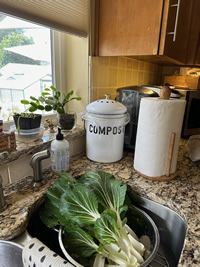
Our Compost Journey
The Kitchen Compost Bin: Initially, we simply used an old plastic bowl to store our kitchen scraps, making daily trips to the compost bin. That became an issue when the warmer weather came around and the flies found it (yuck!). So we decided it was time to find a better option for our kitchen scraps (countertop or under the sink) and started our search. Wow, there are a plethora of many styles, sizes, and features of kitchen countertop composting bins out there!
We eventually decided on a 1.3 gallon Indoor Compost Bucket with a Filtered Lid (shown in image above). Our thought is: Why didn't we do that sooner LOL?
When we started using our new kitchen compost bucket, we were re-using saved grocery store produce bags as bin liners but they are not compostable; after emptying the kitchen scraps into our outdoor compost bin we were tossing that plastic bag into our trash. So, since we having been on a mission to be better stewards to our environment, we thought we should find an alternative to those unrecyclable plastic produce bags.
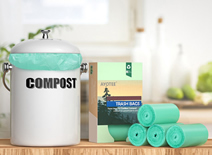 And, there they are! Certified compostable bags! We are now using the 100% Compostable Bags for Kitchen Compost Bin (1.3 gallon size). These bags do begin to deteriorate in a few days when holding wet/organic waste, so the bags/contents should be transferred to the outdoor compost bin daily, or at least every other day. Note: Because these compost bags are made of a natural, renewable starch extract (corn, sugar beet and sugar cane), they do have a short shelf life even when not in use (about a year).
And, there they are! Certified compostable bags! We are now using the 100% Compostable Bags for Kitchen Compost Bin (1.3 gallon size). These bags do begin to deteriorate in a few days when holding wet/organic waste, so the bags/contents should be transferred to the outdoor compost bin daily, or at least every other day. Note: Because these compost bags are made of a natural, renewable starch extract (corn, sugar beet and sugar cane), they do have a short shelf life even when not in use (about a year).
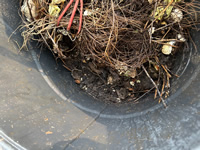 The Outdoor Compost Bin: Our 32 gallon trash can worked great the first year, rotating the contents and adding water as needed to keep it just moist enough to break down the organics. And, because we ONLY add organic materials (as noted in the list above), there has not been any overpowering bad smells or displeasing odors in our bin. It has the aroma of "old vegetables" and "fresh dirt" and not of rotting materials.
The Outdoor Compost Bin: Our 32 gallon trash can worked great the first year, rotating the contents and adding water as needed to keep it just moist enough to break down the organics. And, because we ONLY add organic materials (as noted in the list above), there has not been any overpowering bad smells or displeasing odors in our bin. It has the aroma of "old vegetables" and "fresh dirt" and not of rotting materials.
As our compost pile grew, however, it became difficult and cumbersome to properly rotate the composted materials. 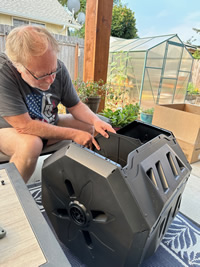 So, we decided to invest in a new, very reasonably priced, Dual-Chamber Compost Tumbler Bin.
So, we decided to invest in a new, very reasonably priced, Dual-Chamber Compost Tumbler Bin.
After a month of use, we have been quite impressed with our new rotating bin! This compost bin is sturdy, easy to spin, and has been composting quite nicely.
Note: The customer reviews say these bins are difficult to put together with so many screws and parts. However we did not find that to be the case at all. Assembly was a breeze!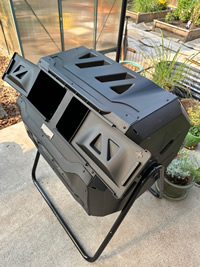
Also, this particular model can be assembled with or without the dual chamber separator (we chose to install the separator for a dual chamber bin).
So, all in all, our composting journey has been very successful and even enjoyable, so far. Home composting takes some commitment and dedication, but the reward of rich, organic humus for your flowers and vegetables is well worth it!
What are you waiting for? Get started composting today. Your garden will love you for it!
Affiliate Disclosure Statement: Some of the links on this page are affiliate links, which means that we may earn a commission or compensation if you click on the link or make a purchase using the link. When you make a purchase, the price you pay will be the same whether you use the affiliate link or go directly to the website using a non-affiliate link. By using our affiliate links, you are helping our website, and we genuinely appreciate your support!
Epicenter Supplies LLC is a participant in affiliate programs. When you click on any affiliate link or ad on our site, and are taken to a third party website, please check that site’s privacy policy if you want to learn how your personal information is used by that site.
